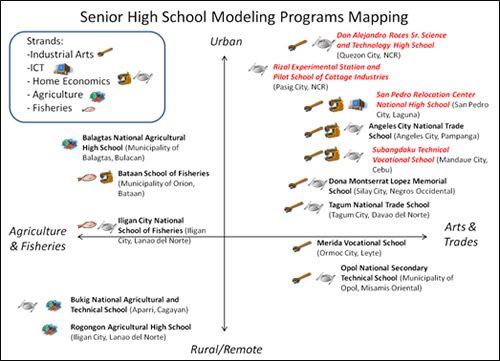Project News
2015-02-04
Visiting Model Schools
As already described in the "Project News" article on June 24, 2014, the Project Team has visited ten model schools and their DepED division offices to study how the preparation for SHS program was going in the respective areas as the preparation for activities in the project's second year (starting from June, 2015).
The chart below shows the situations of four pilot schools (written in red) and ten model schools. The location of the schools (urban/suburb) is shown on the vertical axis, while their specialization (agriculture & fisheries/industrial arts) is shown on the horizontal axis.

Arts and Trade Schools
There are five arts and trade schools. While Angeles City National Trade School, Tagum National Trade School and Doña Monteserrat Lopez Memorial School are located in urban areas, Opol National Secondary Technical School and Merida Vocational School are located in smaller cities. Industry immersion and employment of students are sometimes affected by the location of schools. For example, it is more difficult to develop partnerships with industry for Opol National Secondary Technical School than for schools located in a big city, since the number of companies is limited.Merida Vocational School is now under repair due to damage caused by Typhoon Yolanda in November 2013.
Agricultural Schools
Three model schools are agricultural schools. While Balagtas National Agricultural High School is located in an urban area, Bukig National Agricultural Technical School and Rogongon Agricultural High School are located in remote areas. The schools located in remote areas have difficulty create opportunities for industry immersion and internships for students. To overcome the difficulty, Bukig National Agricultural Technical School sells products made by students on the bread and pastry course and utilizes the income as a subsidy for transportation fees for industry immersion and internship. In Rogongon Agricultural High School, each student is encouraged to have to at least 1 ha farm to cultivate from Grade 7 to Grade 12 as laboratory farm within the community. The school supports students' production activities in order to demonstrate that agriculture could be a sustainable livelihood for the community.
Fishery Schools
Bataan School Fisheries and Iligan City National School of Fisheries are fishery schools. Currently both schools provide multiple specializations other than those associated with fisheries. Bataan School Fisheries has established courses related to food processing and garments based on the needs of local communities and the nearby industrial park. Iligan City National School of Fisheries also has a food processing course. For students attending a fishery course, the school provides training in welding and encourages their students to obtain a related TESDA National Certificate.
Common issues were found such as lack of qualified teachers, a lack of appropriate facilities and equipment, and a high drop-out rate in SHS modeling. The Project will tackle with those challenges through providing competitive grants in the project's second year.
- About JICA
- News & Features
- Countries & Regions
- Our Work
- Thematic Issues
- Types of Assistance
- Partnerships with Other Development Partners
- Climate Change / Environmental and Social Considerations
- Evaluations
- Compliance and Anti-corruption
- Science and Technology Cooperation on Global Issues
- Research
- JICA Development Studies Program / JICA Chair
- Support for the Acceptance of Foreign HRs / Multicultural and Inclusive Community
- Publications
- Investor Relations
